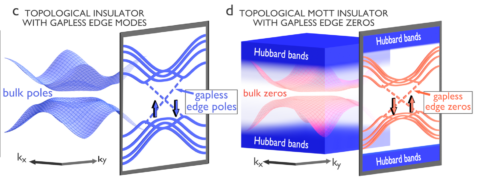New Nature Comm. article: Mott insulators with boundary zeros
The topological classification of electronic band structures is based on symmetry properties of Bloch eigenstates of single-particle Hamiltonians. In parallel, topological field theory has opened the doors to the formulation and characterization of non-trivial phases of matter driven by strong electron-electron interaction. Even though important examples of topological Mott insulators have been constructed, the relevance of the underlying non-interacting band topology to the physics of the Mott phase has remained unexplored. Here, we show that the momentum structure of the Green’s function zeros defining the “Luttinger surface” provides a topological characterization of the Mott phase related, in the simplest description, to the one of the single-particle electronic dispersion. Considerations on the zeros lead to the prediction of new phenomena: a topological Mott insulator with an inverted gap for the bulk zeros must possess gapless zeros at the boundary, which behave as a form of “topological antimatter” annihilating conventional edge states. Placing band and Mott topological insulators in contact produces distinctive observable signatures at the interface, revealing the otherwise spectroscopically elusive Green’s function zeros.
Preprint: https://arxiv.org/abs/2301.05588
Nature Comm. article: https://www.nature.com/articles/s41467-023-42773-7

